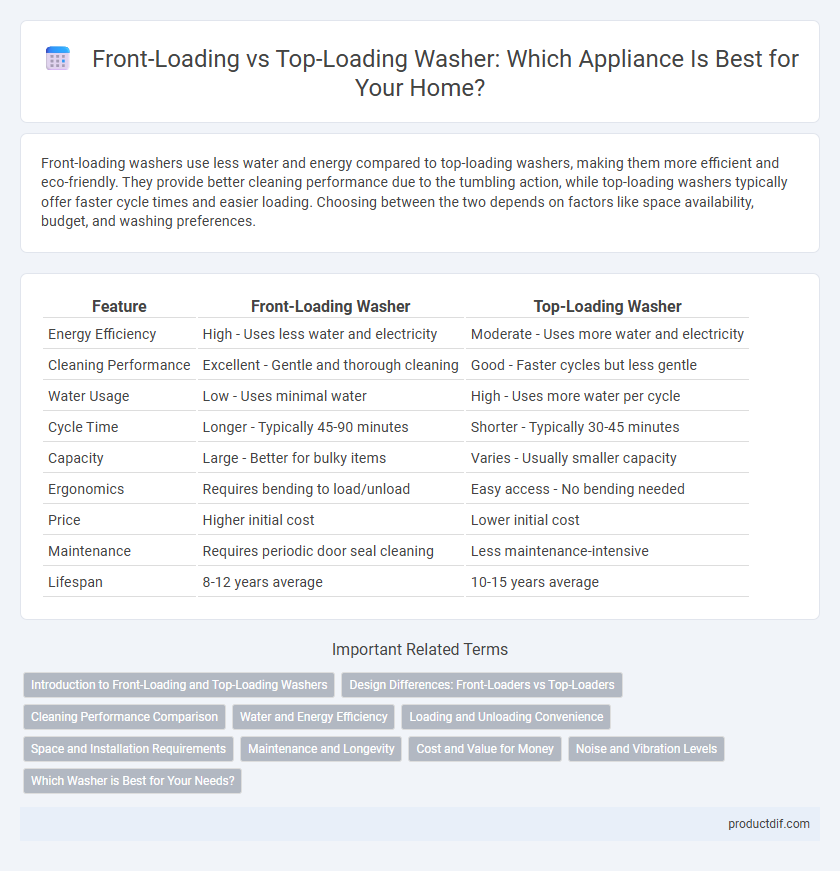Front-loading washers use less water and energy compared to top-loading washers, making them more efficient and eco-friendly. They provide better cleaning performance due to the tumbling action, while top-loading washers typically offer faster cycle times and easier loading. Choosing between the two depends on factors like space availability, budget, and washing preferences.
Table of Comparison
| Feature | Front-Loading Washer | Top-Loading Washer |
|---|---|---|
| Energy Efficiency | High - Uses less water and electricity | Moderate - Uses more water and electricity |
| Cleaning Performance | Excellent - Gentle and thorough cleaning | Good - Faster cycles but less gentle |
| Water Usage | Low - Uses minimal water | High - Uses more water per cycle |
| Cycle Time | Longer - Typically 45-90 minutes | Shorter - Typically 30-45 minutes |
| Capacity | Large - Better for bulky items | Varies - Usually smaller capacity |
| Ergonomics | Requires bending to load/unload | Easy access - No bending needed |
| Price | Higher initial cost | Lower initial cost |
| Maintenance | Requires periodic door seal cleaning | Less maintenance-intensive |
| Lifespan | 8-12 years average | 10-15 years average |
Introduction to Front-Loading and Top-Loading Washers
Front-loading washers feature a horizontal drum and door on the front, offering energy efficiency, gentle fabric care, and better water conservation compared to top-loading models. Top-loading washers have a vertical drum accessible from the top, providing faster wash cycles and easier loading for users with mobility challenges. Both types vary in capacity, energy consumption, and space requirements, influencing user preference based on household needs and laundry habits.
Design Differences: Front-Loaders vs Top-Loaders
Front-loading washers feature a horizontal drum design, allowing clothes to tumble gently for effective cleaning and reduced fabric wear, while top-loading washers use a vertical drum and agitation system that typically offers faster wash cycles but can be harsher on garments. Front-loaders are often designed with a sleek, stackable form factor, saving space in laundry rooms, whereas top-loaders require more vertical clearance and usually cannot be stacked. The ergonomic differences influence loading convenience and maintenance, with top-loaders allowing easier access without bending and front-loaders often requiring loading at waist level.
Cleaning Performance Comparison
Front-loading washers generally deliver superior cleaning performance due to their tumbling action, which agitates clothes more gently but effectively, removing dirt and stains with less water and detergent. Top-loading washers often struggle with heavily soiled items as their agitator design can be less efficient in penetrating deep into fabric fibers, potentially leaving residues behind. Studies show front-loaders consistently achieve higher soil removal ratings and better overall fabric care, making them the preferred choice for thorough cleaning.
Water and Energy Efficiency
Front-loading washers use up to 40% less water and 50% less energy than top-loading washers due to their horizontal drum design and efficient tumbling action. Top-loading washers typically consume more water to submerge clothes fully and generally require more energy for heating and spinning cycles. Choosing a front-loading washer improves energy efficiency and reduces utility bills while supporting sustainable water conservation.
Loading and Unloading Convenience
Front-loading washers offer easier loading and unloading due to their ergonomic waist-high door position, significantly reducing back strain compared to top-loading washers that require reaching down into the drum. The horizontal drum design in front-loaders allows clothes to tumble freely, preventing tangling and enabling efficient cleaning with minimal water usage. Conversely, top-loading washers provide quicker access but can be less convenient for those with limited mobility or back issues, making front-load models preferable for enhanced user comfort and practicality.
Space and Installation Requirements
Front-loading washers typically require more clearance for door swing and may need additional space for stacking with a dryer, making them ideal for compact laundry rooms with vertical space. Top-loading washers demand more horizontal space due to the lid opening upward, which can limit installation options in tight or confined areas. Both appliance types require access to standard water and electrical connections, but front-loaders often need a slightly reinforced floor to support heavier machines during the spin cycle.
Maintenance and Longevity
Front-loading washers typically require regular gasket cleaning and door seal maintenance to prevent mold and mildew buildup, extending appliance lifespan. Top-loading washers often experience fewer issues with mold, but their agitator components may require more frequent inspection and lubrication to maintain performance. Both washer types benefit from routine cleaning cycles and proper detergent use to ensure long-term reliability and efficiency.
Cost and Value for Money
Front-loading washers generally cost more upfront than top-loading washers but offer superior energy and water efficiency, resulting in lower utility bills over time. Top-loading washers have a lower initial price, making them budget-friendly, but tend to consume more water and energy, which can increase long-term operating costs. Investing in a front-loading washer often provides better value for money due to durability, gentle fabric care, and reduced utility expenses.
Noise and Vibration Levels
Front-loading washers generally operate with lower noise and vibration levels due to their horizontal drum design and advanced suspension systems, making them ideal for washing near living areas. Top-loading washers tend to produce more noise and noticeable vibration because their vertical drum and agitator mechanism create increased mechanical movement during cycles. Noise ratings for front-loaders typically range between 50-60 decibels, whereas top-loaders can reach up to 70 decibels, impacting overall laundry room comfort and usability.
Which Washer is Best for Your Needs?
Front-loading washers offer superior energy efficiency and gentler fabric care, making them ideal for frequent laundry loads and delicate clothing. Top-loading washers typically provide faster wash cycles and easier loading, suited for users prioritizing convenience and shorter wash times. Your choice depends on space availability, budget, and specific laundry requirements such as fabric type and wash frequency.
Front-loading washer vs top-loading washer Infographic

 productdif.com
productdif.com